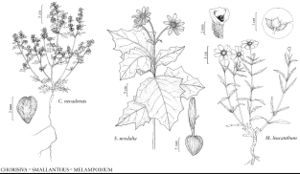Melampodium
Sp. Pl. 2: 921. 1753.
Gen. Pl. ed. 5, 392. 1754.
| Taxon | Illustrator ⠉ | |
|---|---|---|
 | Chorisiva nevadensis Smallanthus uvedalia Melampodium leucanthum | Yevonn Wilson-Ramsey Bee F. Gunn Yevonn Wilson-Ramsey |
Annuals, perennials, or subshrubs, 5–50 (–150+) cm. Stems erect or prostrate. Leaves cauline; opposite; petiolate (petioles usually winged) or sessile; blades deltate, lance-elliptic, lanceolate, lance-linear, linear, linear-oblong, ovate, or rhombic, sometimes pinnately lobed, ultimate margins entire or toothed, faces usually hairy, usually glanddotted (at least abaxial). Heads radiate, borne singly (from forks of branches, peduncles often uncinate). Involucres mostly hemispheric (sometimes ± cupulate), [4–] 5–20 (–30+) mm diam. Phyllaries persistent (outer) or falling with cypselae, 8–20+ in 2 series (outer [2–] 5 often ± connate, herbaceous, inner each investing a ray ovary, forming a perigynium, shed with enclosed cypsela). Receptacles flat or convex to conic (their tips, paleae, and spent florets often shed as a unit), paleate (paleae lanceolate to linear, scarious, conduplicate, often with dilated, erose tips). Ray-florets [3–] 5–13+, pistillate, fertile; corollas yellow, orange, or cream-white, sometimes purplish abaxially (tubes often wanting). Disc-florets [3–] 45–70 [–100+], functionally staminate; corollas ochroleucous, yellow, or orange, tubes shorter than funnelform throats, lobes 5, ± deltate. Cypselae each enclosed within and shed with a smooth, sculpted, or tuberculate, scarious, coriaceous, or hardened perigynium (the ultimate “fruits” ± compressed, ± D-shaped); pappi 0. x = 12.
Distribution
United States, Mexico, West Indies, Central America, South America, in Old World
Discussion
Species ca. 36 (7 in the flora).
Selected References
Lower Taxa
Key
| 1 | Perennials; ray corollas cream-white | > 2 |
| 1 | Annuals; ray corollas yellow to yellow-orange | > 3 |
| 2 | Outer phyllaries connate 1/2–3/5 their lengths; ray laminae 7–13 × 2.5–8 mm | Melampodium leucanthum |
| 2 | Outer phyllaries connate 1/6–1/3+ their lengths; ray laminae 2–8+ × 1–3+ mm | Melampodium cinereum |
| 3 | Leaf blades deltate or rhombic to lanceolate, lengths 1–2(–3) times widths | > 4 |
| 3 | Leaf blades lance-elliptic or oblanceolate to linear, lengths (3–)4–8+ times widths | > 5 |
| 4 | Outer phyllaries ovate, 3.5–6 mm, connate 1/4–1/3 their lengths; disc florets 40–70+; fruits 2.8–4 mm | Melampodium divaricatum |
| 4 | Outer phyllaries oblong-elliptic, (6–)8–15+ mm, connate 0–1/6 their lengths; disc florets 30–45; fruits 4–7 mm | Melampodium perfoliatum |
| 5 | Outer phyllaries connate 3/5–2/3 their lengths; disc florets 25–40 | Melampodium appendiculatum |
| 5 | Outer phyllaries connate 0–1/6 their lengths; disc florets 4–10 | > 6 |
| 6 | Peduncles 4–30+ mm; rays 7–12, laminae 1.2–1.5 mm; disc florets 8–10 | Melampodium longicorne |
| 6 | Peduncles 0–3(–12+) mm; rays 5–8, laminae 0.6–1.1 mm; disc florets 4–6 | Melampodium strigosum |